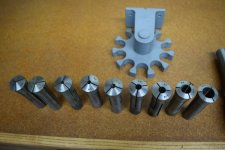What part of Washington are you in?
I would think a worn out milling machine would be 10 times the machine one could possibly ever make that drill press into.
I have seen some serviceable with some tooling for 2k to the sky is the limit.
Here is one that looks nice in pics.
I just have a hard time saying precision rifle work and HF drill press in the same sentence. I won't say you can't do your work that way but it is an uphill battle with no end in my opinion. If you want do precision work you will find it much easier with precision tools. Most anything you could want for an old Bridgeport can be bought to repair it. Now that said, a Bridgeport is not the best thing out there, it is way better than what you started out talking about, you shouldn't have to lose any money on one if you buy a nice one.
View attachment 344254View attachment 344255View attachment 344256
1956 Bridgeport J-Head milling machine 9” X 42”. The motor is 1 HP 3-phase, but comes with a 3-phase converter so you can use household 20 amp 220.
I bought this for reasons unknown. I restored it as a 2-year project, and then have never really used it. I had this machine soda blasted and professionally painted at Rick’s Auto Body in Missoula, Montana.
I am scaling back my metal shop and this is no longer needed.
These units are selling unrestored for anywhere from $3,500.00 to $5,000.00. With the complete restoration, I believe $3,250.00 is very fair. You won’t find used Bridgeports (which are the standard in the industry) in this good condition.
All parts are available and power feed, etc., can be added. It has a brand-new set of collets, clamping vice (nice, new).
The machine weighs about 2500 pounds. I can load it into your trailer or a freight company rig. No charge to load, but packing and freight is extra. This may fall under class 85 to ship.
1956 Bridgeport J-Head milling machine - tools - by owner - sale
1956 Bridgeport J-Head milling machine 9” X 42”. The motor is 1 HP 3-phase, but comes with a 3-phase converter so you can use household 20 amp 220.
I bought this for reasons unknown. I restored it as a 2-year project, and then have never really used it. I had this machine soda blasted and professionally painted at Rick’s Auto Body in Missoula, Montana.
I am scaling back my metal shop and this is no longer needed.
These units are selling unrestored for anywhere from $3,500.00 to $5,000.00. With the complete restoration, I believe $3,250.00 is very fair. You won’t find used Bridgeports (which are the standard in the industry) in this good condition.


 . Makes me think the square ain't that square, or the rod is tapered. I'll revisit at a later time, going with what the spindle square indicated.
. Makes me think the square ain't that square, or the rod is tapered. I'll revisit at a later time, going with what the spindle square indicated.


